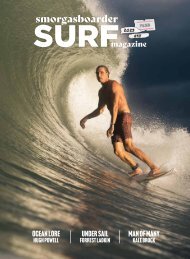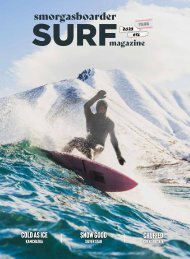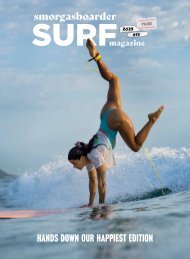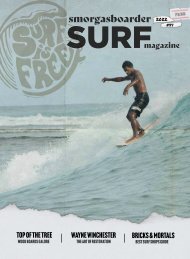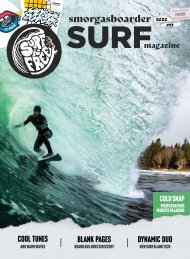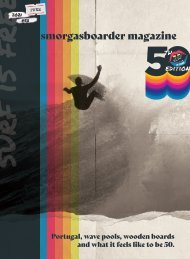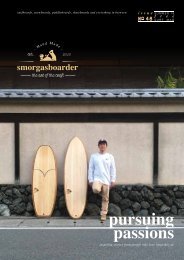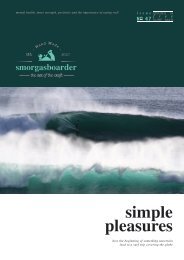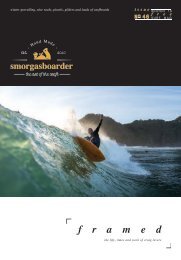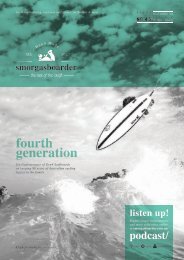SB-issue59_digital
You also want an ePaper? Increase the reach of your titles
YUMPU automatically turns print PDFs into web optimized ePapers that Google loves.
Documentary by Matty Hannon<br />
Each of these Zapatista<br />
rebels, Amazonian shamans,<br />
and Mapuche leaders<br />
describe the harsh<br />
consequences of today’s<br />
dominant systems, and how<br />
their ancient lifestyles<br />
have conflicted with the<br />
modern attitude that humans<br />
are separate from, and even<br />
superior to, nature.<br />
CLOSING<br />
DOWN<br />
SALE<br />
“As a filmmaker, you have the privilege to help them share that story. It<br />
comes with a lot of responsibility, but without a doubt that’s my favourite<br />
part. Often, we used music, imagery, and the ‘feeling’ of the story to convey<br />
those ideas, rather than over-explain them with words and language.”<br />
That’s the great thing about The Road to Patagonia. As such a passionate<br />
dirtbag production, it excels at communicating ideas like animism – the belief<br />
that all things, places, and creatures have some kind of spiritual essence.<br />
It’s a gorgeous-looking film, simply because what you see is what you<br />
get – nature and humanity in its rawest form, with few fancy techniques or<br />
overcomplicated edits to mask that.<br />
To that end, I was both surprised and delighted to hear that the cameras<br />
Matty used were relatively cheap by today’s standards, and even archaic by<br />
today’s average video specs.<br />
“I used DSLR cameras for the most part – a Canon 5D Mark2 and a Sony<br />
A7s. Most phones shoot better footage these days. Actually, I even used<br />
phone footage in the film a few times as well.<br />
“People get so hung up on the tech, like the best films are shot on RED<br />
or whatever, but at the end of the day, the best cakes aren’t baked in a<br />
particular oven. It’s story over everything for me.<br />
“I had a drone at the start, but at one point it was stolen and I lost all of the<br />
footage along with it. Funnily enough, I’m now stoked we don’t have any<br />
drone footage in the film. It’s given the scenes a close and personal feeling.”<br />
Shooting the Road to Patagonia was one thing, but editing it was something<br />
entirely different. After arriving home in one piece, Matty lived in an old rusty<br />
caravan, trading work on a nearby farm for free rent so he could afford to<br />
continue editing the film.<br />
As it turns out, the difficulties Matty faced on his precarious journey across<br />
the length of the world paled in compassion to waking up and summoning<br />
the motivation to sit at a computer for up to ten hours a day… for four years<br />
straight.<br />
Hearing this, my heart certainly broke for him. Thankfully, with the help of a<br />
small team, he eventually figured out how to turn 16 years of footage into a<br />
one-and-a-half-hour documentary, which Matty said was the gnarliest puzzle.<br />
All stock must be<br />
cleared by October 31<br />
“Editing was tough, but getting funding for post-production was an elating<br />
milestone, as prior to then, everything had been such a battle.<br />
“A highlight was discovering the language around animism. That was a big<br />
breakthrough. Then, Daniel Norgren offered to provide music for the film,<br />
which was incredible. He’s so talented and evocative.<br />
“I knew then, seven years in, that we were gonna make a special little film. I’d<br />
never make it again this way in the future, but ironically, the difficulties of this<br />
film are also its strengths. The harder it got, the more the film benefitted.”<br />
1/12 The Terrace,<br />
Brunswick Heads NSW<br />
p: 02 6685 1283<br />
#59 // smorgasboarder //<br />
57



